Abstract
The formation and development of the computational thinking of the future specialist is one of the main goals of modern higher education. In this regard, special attention should be paid to the disciplines related to programming and numerical methods for solving mathematical problems. One of the reasons for the decline in the quality of mastering these disciplines is the lack of means and methods of teaching students, taking into account their modern cognitive characteristics. The purpose of the study is to substantiate, develop and experimentally test cognitive means and methods of teaching students Numerical Methods, which contribute to the development of their computational thinking and ensure the effectiveness of subject training. The leading methodological strategy of the research is the cognitive approach to teaching, associated with the implementation of the psychological and pedagogical goals of the cognitive process and focused on the use of cognitive visualization of educational mental constructs. The scientific idea of developing students' computational thinking and increasing the effectiveness of their training in the Numerical Methods course with the help of original cognitive-visualized teaching aids and dynamic computing simulators is proposed and implemented. In the course of the pedagogical experiment, the effectiveness of cognitive means and methods of teaching students Numerical Methods is shown.
Keywords: Cognitive trainers, computational problems, computational thinking, numerical methods
Introduction
Currently, the development of the concept of "computational thinking", which is a key skill of a modern specialist, is of great interest. Among foreign scientific and educational organizations, it should be noted the work in this direction of the US National Academy of Sciences, the British Computer Society (BCS, The Chartered Institute for IT), the International Society for Technology in Education (ISTE), the Google Academy, etc. The phenomenon of the emergence of computational thinking has deep historical roots. Its evolutionary formation begins with the emergence of counting and the development of measuring instruments and methods. They became the basis for knowledge of the surrounding world and mind. In this regard, the emergence and rapid development of computer technology and IT technologies should be recognized as natural, which significantly influenced the multidimensional worldview of people and their computational thinking. The ability to think in general, and to think in a new way in particular, is largely facilitated by computational problems. From this point of view, disciplines related to programming and numerical methods for solving mathematical problems deserve special attention in the educational programs of universities. They affect not only the high level of mathematical training of students, but also the formation and development of their computational thinking.
Problem Statement
The author's experience of teaching students Numerical Methods in recent years shows a noticeable decrease in the quality of mastering this discipline. One of the reasons for this is the lack of tools and methods for teaching students numerical methods that take into account their modern cognitive characteristics (generation Z).
Research Questions
Thus, the research problem should be stated: what should be the means and methods of teaching students the Numerical Methods course to ensure the development of their computational thinking and increase the effectiveness of mastering this discipline?
To achieve this goal, the following tasks were set and solved:
- Analysis of approaches to teaching Numerical Methods in university education and the identification of the essence of computational thinking.
- Substantiation and development of a model for the development and diagnosis of computational thinking of students in the course of studying the Numerical Methods course.
- Development of cognitive tools and methods of teaching students Numerical Methods.
Conducting a pedagogical experiment to substantiate the effectiveness of the use of cognitive tools and methods for the development of computational thinking of students in the study of Numerical Methods.
Purpose of the Study
The purpose of this work is related to the substantiation, development and experimental testing of cognitive tools and methods of teaching students Numerical Methods, contributing to the development of their computational thinking, and ensuring the effectiveness of subject training.
Research Methods
The theoretical and methodological basis of the research was the work in the field of the following: a systematic approach; an activity-based approach to learning; cognitive psychology, which deals with the study of cognitive processes in learning; informational approach in education, focused on the implementation of psychological and pedagogical learning goals and the use of cognitive visualization, aimed at building mental constructs for conscious thinking and decision-making in learning; theory, practice and methods of teaching Numerical Methods. To solve the set tasks, the following methods were used: theoretical (analysis of the Federal State Educational Standard of Higher Professional Education; analysis of scientific and methodological literature on the research topic; analysis and systematization of the author's pedagogical experience of teaching the Numerical Methods course; information modeling); empirical (observation; questioning; testing; pedagogical experiment); statistical (quantitative and qualitative analysis of results by methods of mathematical statistics).
Findings
The analysis of the working programs showed that the approaches to teaching Numerical Methods for different areas of training are significantly different. In technical universities, more attention is paid to solving real engineering problems, to which effective methods of solving are selected. In pedagogical universities, the methodology of teaching the course is more important. For specialists in natural sciences, an important role is played by the construction of an algorithm, an assessment of the accuracy of solving a problem, an analysis of the effectiveness of the method and the limitations in its use.
Researchers believe that students need to be taught to set mathematical problems, to apply numerical methods implemented in one of the programming languages to solve them. In this case, students develop skills in modeling various processes, algorithmic and computational-mathematical skills to solve problems using computer technologies, the ability to assess the reliability of the results. The noted cognitive qualities form the foundation of the computational thinking (CT) of the learner. Analysis of the concepts for the definition of this concept made it possible to single out three of them, which are the most significant (Lee et al., 2011; Wing, 2006):
- CT is a cognitive thought process.
- CT is a hybrid of other ways of thinking.
- CT – the application of Computer Science methods to simulate processes studied in other disciplines.
Some aspects of the development of individual components of computational thinking were considered in the works of Russian researchers (Barhatova & Nigmatulina, 2017; Khenner & Semakin, 2014; Pak et al., 2019; Pushkareva et al., 2017). From the standpoint of the cognitive approach (Klunnikova et al., 2020), computational thinking represents thinking mental schemes (Neisser, 1981) of information exchange between a person and the outside world using IT technologies. According to the cognitive model of the student's information interaction with the learning environment, the essence of learning is determined by two stages:
Formation of connections between images of the sensory zone and their model representations (intuition stage). Systematization of intuitive experience using concepts and terms of the subject area (stage of formation and development of conscious thinking). At the stage of intuitive learning, it is advisable to present the educational material in the form of mental schemes, the structure of which is described in detail in the article by Klunnikova (2019). For example, a mental diagram of the exact Gauss method for solving systems of linear algebraic equations is shown in Figure 1.
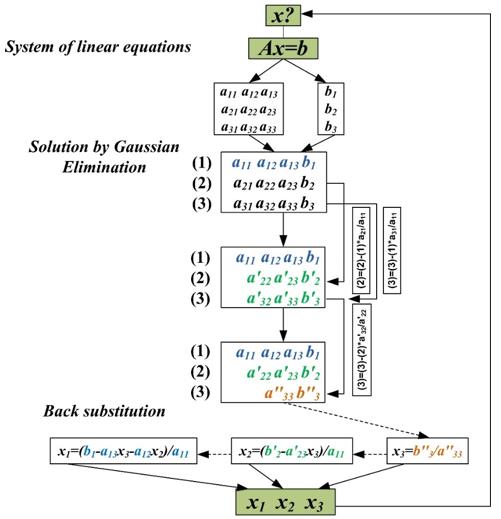
For the formation and development of such schemes in the process of teaching the Numerical Methods course it is advisable to use cognitively visualized teaching aids: cognitive (mental) maps, visual simulators, lectures-simulators, and tests-simulators.
Cognitive maps allow students to form images of abstract mathematical concepts, critically analyze subject material, increase the degree of memorization of calculation schemes at an intuitive level, and present a holistic picture of the application of numerical methods in professional activities. Cognitive visualization involves the folding of information, i.e. reduction of the physical volume of information, which ensures its more effective understanding, assimilation, and application. This allows you to explore various properties of objects, identify and generate new knowledge, and, as a result, improves the mental abilities of students, which is especially important in conditions of an increase in the information load on students.
A significant cognitive effect of teaching numerical methods is observed when compiling mental computational maps by the students themselves during practical work and independent work. Here the advantage of the projective-recursive learning technology, described in the work of Bazhenova and Pak (2016), is manifested.
Visual simulators are an effective tool for studying the work of numerical methods. Visual simulation is a visual imitation of the algorithm's operation, based on the fact that the student takes on the role of the executor of the program: enters the initial parameters of the program, reads the code, monitors the step-by-step execution of commands in the appropriate order. Such activities contribute to understanding the operation of the algorithm and improving the skills of writing your own programs. Visual simulators can be used in lectures to explain theoretical material and analyze algorithms.
Such a product should have the following properties: interactivity and visibility; displaying the progress of the algorithm; support for step-by-step and automatic rendering modes; ease of inclusion of the generated web page in the electronic course. Visual simulators of two types have been developed for the electronic course.
The first type is aimed at demonstrating the operation of the numerical method, without showing its software implementation. The interactive element allows the student to enter the necessary input parameters or use built-in examples, see the step-by-step operation of the method with text explanations, automatically generated analytical expressions, see the process of calculations on graphs of various types. At the same time, a metagraphic arrangement of information is used, which makes the information motivated and more expressive for an adequate interpretation of educational materials. The introduction of an interactive element into an electronic course is performed by the administrator, the mechanism for obtaining a ready-made markup for an interactive element is reduced to the copy-paste method, and the code of interactive elements is updated without updating the markup. To systematize all the developed interactive elements and examples for them, a demo site was developed https://numerical-methods.sfu-kras.ru/. The site pages contain working interactive elements and markup, with the help of which these elements are embedded in LMS Moodle. Using the developed framework, numerical methods were implemented to solve various problems.
Simulators of the second type simulate the work of the program code that implements the work of the numerical method in steps. The architecture of the developed product is shown schematically in Figure 2.
The developed software receives as input a file with the source code of a program in C ++, converts it into a set of tokens, on the basis of which a bracket tree is built, then the bracket tree is parsing - the process of converting ordinary text into a data structure called an abstract syntax tree (AST). After the AST is formed and checks are performed, this structure is used to generate the bytecode. The virtual machine interprets the received bycode. The resulting web page is easily integrated into an electronic course based on LMS Moodle. The utility allows you to create dynamic simulators that help students understand the principles of the algorithms of numerical methods. In this case, the student can enter various initial parameters, see what happens to the variables during the execution of the program. To improve clarity, the utility allows, if necessary, to connect a module for graphical display of calculation results. Using this approach, you can create similar simulators in other disciplines, one way or another related to programming.
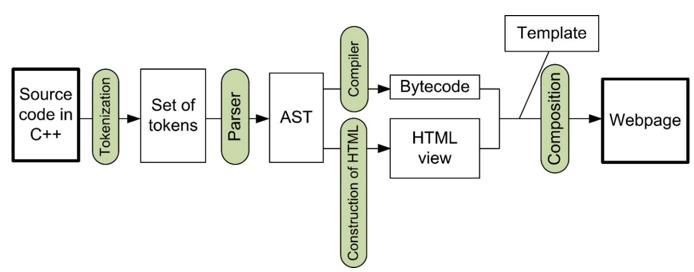
Considering learning from the standpoint of mental schemes and mental models, which ultimately determine computational thinking, a step-by-step recursive way of teaching students numerical methods is proposed (Bazhenova, 2015; Klunnikova, 2020).
To substantiate the effectiveness of the developed cognitive tools and methods of teaching students, a pedagogical experiment was carried out, which was carried out with the involvement of 3rd year students of the Schools of Mathematics and Computer Science of the Siberian Federal University.
As part of the experiment, introductory testing of the control and experimental groups was carried out to assess the level of their readiness to master the Numerical Methods course. To compare the distributions of objects in the two populations, the Pearson χ2 test was used. It has been proved that "at the beginning of the experiment" there are no statistically significant differences in the characteristics of the control and experimental groups.
Assessment of the level of formation of students' computational thinking was assessed according to three criteria: content (points scored by a student during intermediate and final testing of knowledge); operational (the level of a student's intellectual development, reflecting his ability to compare, classify, generalize, evaluate using R. Amthauer's tests); cognitive activity (automatic analysis of the volume of a student's independent work within the framework of an electronic course by means of LMS Moodle).
The diagnostic results of the control and experimental groups at the beginning of the experiment and at the time of its completion are shown below (Figure 3-4).
As a null hypothesis (H0), we will consider the following: mastering Numerical Methods does not depend on the changes proposed in the teaching methodology. An alternative hypothesis (H1) is formulated as follows: the levels of learning in the two groups are different and this difference is caused by the use of the proposed cognitive learning tools. The study allows us to conclude that the use of the methodology for the development of computational thinking of students in teaching Numerical Methods increases the level of their subject knowledge, and the higher the level of computational thinking among students, the higher their progress in the Numerical Methods course. The increase in the average score in Numerical Methods after the experiment is clearly shown in Figure 5.
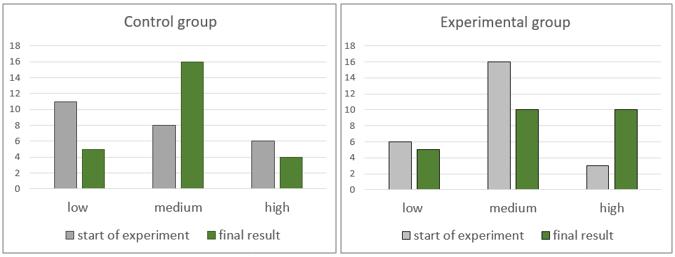
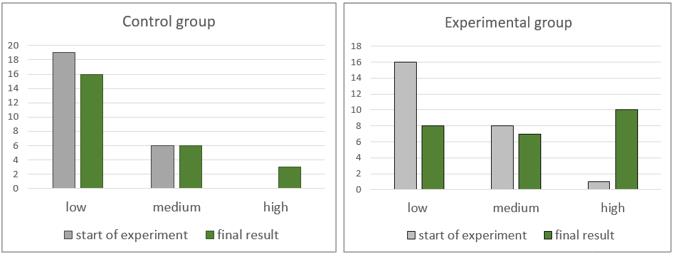
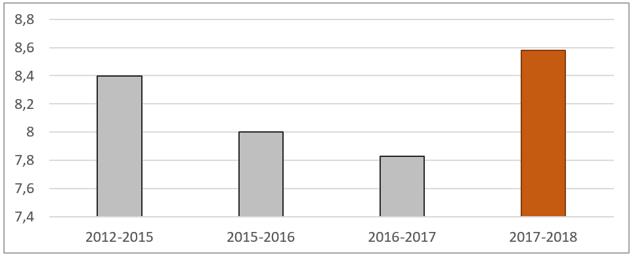
Conclusion
The formation and development of the student's computational thinking is carried out through the study of different disciplines. Perhaps the main contribution to this process is made by the disciplines related to programming and numerical methods for solving mathematical problems. Special means and methods of teaching students, taking into account their modern cognitive features, can significantly improve the methodological systems of teaching students, in particular, the Numerical Methods course. The paper proposes and substantiates the scientific idea of developing students' computational thinking and increasing their training efficiency in the Numerical Methods course with the help of original cognitive-visualized teaching aids and dynamic computing simulators. These include cognitive maps, visual simulations, simulator lectures, and simulator tests. The developed electronic course based on LMS Moodle (address https://e.sfu-kras.ru/course/view.php?id=2423) provides individualization of independent educational activities of students, contributes to the successful development of numerical methods. The developed means and methods for the development of computational thinking of students in the process of their study of Numerical Methods were tested in the real educational process for 3rd year students of the Institute of Mathematics and Fundamental Informatics of the Siberian Federal University.
In the course of the research, conceptual maps were created on all topics of Numerical Methods, visual simulators of the operation of algorithms, dynamic computational simulators that provide the cognitive nature of learning. To assess the level of formation of students' computational thinking, a diagnostic model has been developed. In order to increase the motivation and individualization of independent educational activities of students, a special structure and content of an electronic course has been created, including lectures-simulators and tests-simulators.
Thus, the work substantiates the effectiveness of cognitive means and methods of teaching students Numerical Methods, contributing to the development of their computational thinking and ensuring the effectiveness of subject training.
The presented materials of the article can be useful for teachers of educational institutions leading the Numerical Methods course, as well as those who prefer to use cognitive computer technologies in the educational process.
Acknowledgments
This study was carried out within the framework of the International Program of Scientific Grants for Conducting Research based on the Institute for Advanced Studies of the Moscow Pedagogical State University (Moscow, Russia), as well as project № 2021012106985 “Formation and development of computational thinking of students on the basis of automated and cognitive teaching tools” was supported by Krasnoyarsk Regional Fund of Science (Krasnoyarsk, Russia).
References
Barhatova, D. A., & Nigmatulina, E. A. (2017). Bodily-mental approach to teaching informatics using natural-didactic means. The Krasnoyarsk State Pedagogical University named after V.P. Astafiev, Krasnoyarsk.
Bazhenova, I. V. (2015). Metodology of projective-recursive training for the programming of students of mathematical training directions. Cand. ped. sci. diss. Krasnoyarsk, SFU. http://research.sfu-kras.ru/sites/research.sfu-kras.ru/files/Bazhenova_0.pdf
Bazhenova, I. V., & Pak, N. I. (2016). Projective-recursive educational technology in personality-oriented education. J. Pedagogical Education in Russia, 7, 7-15.
Khenner, E., & Semakin, I. (2014). School Subject Informatics (Computer Science) in Russia. ACM Transactions on Computing Education, 14, 1-10.
Klunnikova, M. M. (2020). Development of computational thinking of students in the process of learning Numerical Methods. Cand. ped. sci. diss. Krasnoyarsk, SFU. http://research.sfu-kras.ru/sites/research.sfu-kras.ru/files/dissertaciya_Klunnikova.pdf
Klunnikova, M. M. (2019). The methods of developing computational thinking of students while studying the course «Numerical methods» based on blended learning. J. Informatics and Education, 6, 34-41.
Klunnikova, M. M., Bazhenova, I. V., Pak, N. I., & Kirgizova, E. V. (2020). Developing students computational thinking with a recursive polydisciplinary approach. J. of Physics: Conference Series. Krasnoyarsk Science and Technology City Hall. Krasnoyarsk, Russian Federation, 12190.
Lee, I., Martin, F., Denner, J., Coulter, B., Allan, W., Erickson, J., Malyn-Smith, J., & Werner, L. (2011). Computational thinking for youth in practice. ACM Inroads, 2, 32-37.
Neisser, U. (1981). Cognition and reality. The meaning and principles of cognitive psychology. Progress.
Pak, N., Stepanova, T., Bazhenova, I., & Gavrilova, I. (2019). Multidimensional Algorithmic Thinking Development on Mental Learning Platform. Journal of Siberian Federal University. Humanities & Social Sciences, 1072-1087.
Pushkareva, T. P., Stepanova, T. A., & Kalitina, V. V. (2017). Didactic tools for the students’ algorithmic thinking development. The Education and Science Journal, 9, 126-143.
Wing, J. M. (2006). Computational thinking. Commun. ACM 49(3), 33-35.
Copyright information

This work is licensed under a Creative Commons Attribution-NonCommercial-NoDerivatives 4.0 International License.
About this article
Publication Date
25 September 2021
Article Doi
eBook ISBN
978-1-80296-115-7
Publisher
European Publisher
Volume
116
Print ISBN (optional)
-
Edition Number
1st Edition
Pages
1-2895
Subjects
Economics, social trends, sustainability, modern society, behavioural sciences, education
Cite this article as:
Pak, N. I., Klunnikova, M. M., & Balykbaev, T. O. (2021). Development Of Students' Computational Thinking Using Cognitive Tools And Methods Of Teaching. In I. V. Kovalev, A. A. Voroshilova, & A. S. Budagov (Eds.), Economic and Social Trends for Sustainability of Modern Society (ICEST-II 2021), vol 116. European Proceedings of Social and Behavioural Sciences (pp. 308-316). European Publisher. https://doi.org/10.15405/epsbs.2021.09.02.33

